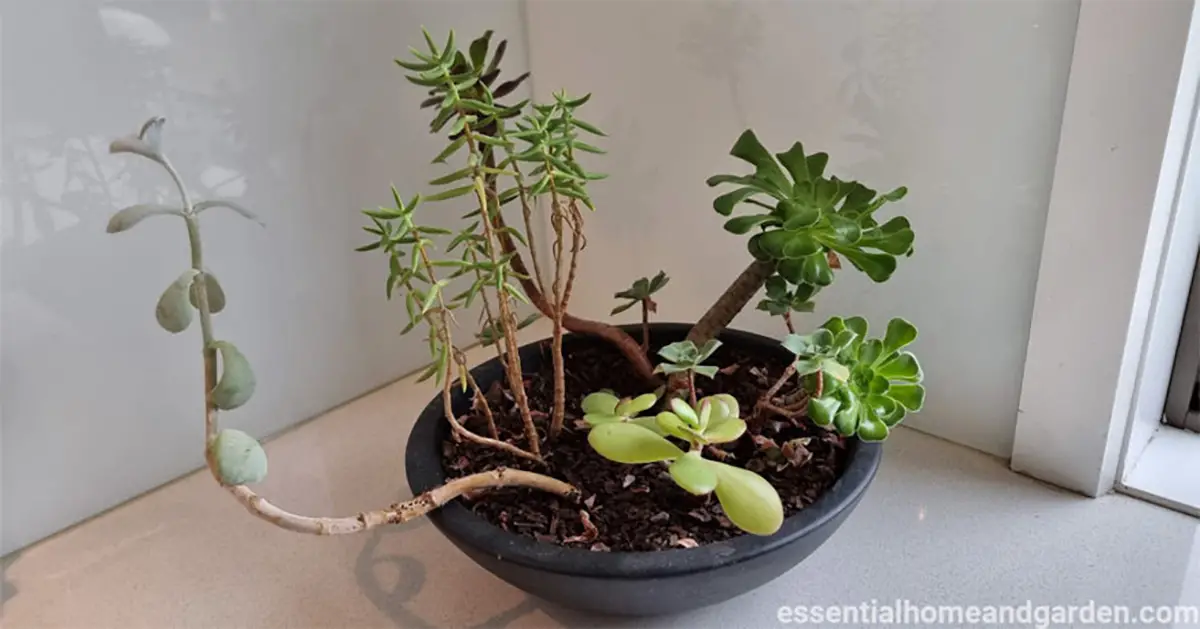Does your succulent look like an adolescent—tall, gangly, and awkward, with limbs that look thin as toothpicks? Does it resemble a Charlie Brown Christmas tree more than it does than the bushy succulent you brought home from the store? What did you do wrong? The simple answer is that your succulent is leggy (or, in technical terms, your succulent is “etiolated”) because it gets inadequate sunlight.
While the diagnosis is easy, the solution is a bit more complicated. Here are our tips on what to do when your succulents become stretched.
Key Takeaways
- Legginess from Low Light: Leggy succulents need more sunlight to prevent stretching.
- Sunlight Needs: Place succulents in bright, direct sunlight for at least six hours a day.
- Outdoor Sun Exposure: Moving succulents outdoors can provide the necessary sunlight for healthy growth.
- Comprehensive Care: Adequate light must be combined with proper watering and soil to improve plant health.
- Propagation Option: Overly stretched succulents can be propagated to create new, healthy plants.
Succulents Need Sunlight
While succulents are tough and can survive with minimal water and no fertilizer, they wither without ample sunlight. Most thrive with six hours of direct sun daily, mimicking their native hot, sunny climates.
Succulents are often perceived as easy-to-care for, resilient plants. That is true, but only to a certain extent. It is possible for anyone, anywhere to grow an indoor succulent (with the right setup). That does not mean you can put a cactus in a bookshelf next to a north-facing window overhung with trees and expect that cactus to thrive, no matter how well you take care of its other needs.
A succulent lacking light will elongate rapidly and may show leaf loss, curling, discoloration, or increased susceptibility to rot and pests.
Ways You Can Fix A Leggy Succulent
Fix A Leggy Succulent With Additional Light
 Source: Sucstu
Source: SucstuNot all succulents can be saved. Just like elastic, once it’s overstretched, you may have to cut it up to shorten it rather than trying to shrink it back into its original state. But propagation isn’t your only option if you quickly catch the problem.
To counteract stretching, place your succulent in a sunny spot, ideally a south-facing window, or use a grow light for up to sixteen hours a day to mimic natural light cycles.
Note: If you live in an appropriate climate and season, another good option would be to place your succulent outdoors in a location with full-day sun exposure. A summer outdoors can be just the thing to revive your succulents each year and prepare them for a winter dormancy indoors.
Fix a Leggy Succulent With Excellent Care

While light is crucial, don’t overlook other care aspects like watering and the right potting mix to nurse a leggy succulent back to health.
For example, if you put your pot outside for the summer to address the legginess, but your plant is improperly potted in a planter with no drainage hole, the first time you get a rainstorm, your succulent is going to drown. Check out our comprehensive guide to succulent care to make sure you’re covering all your plant-care bases.
Note: Make sure your plant doesn’t have anything wrong with it in addition to the sun deprivation. A plant that is weak and sickly due to etiolation is more susceptible to other diseases and pests.
So, for example, before moving your light-starved plant to the crowded windowsill in your south-facing window, you should inspect it for pests to ensure you don’t inadvertently spread mealybugs to your other plants.
Our guide to rescuing dying succulents has a great diagnostic tool to help you identify additional problems that may be contributing to your succulent’s poor health. If your plant is suffering from any other problems, from root rot to nitrogen deficiency to aphids, our guide will help you find the right solution, so that you can give your leggy succulent a fighting chance.
Fix a Leggy Succulent Using Propagation

When succulents are too leggy, propagation can create new, vibrant plants from the overextended original.
If you want lots of plants, you can propagate your etiolated succulent using leaf propagation. While it’s unlikely that every leaf will properly root, leaf propagation could help you turn one leggy succulent into a dozen or more succulent babies.
For more guidance on leaf propagation, you can check out our guide to propagation techniques. However, our preferred way to propagate a leggy succulent is using stem propagation.
How to use propagation to fix leggy succulents
- Water your plant a few days ahead of propagating. You can also prepare by mixing up a batch of potting mix (you can find our favorite recipe here), and clean and sterilize your new pots and a sharp pair of pruning shears or knife (you can use alcohol).
- Start by beheading the plant. Cut it an inch or so above the soil surface, above the lowest few leaves. Then set that plant aside. It may die, but it will likely sprout multiple new offshoots from the cut point, creating a bushy plant instead of a single-stemmed plant. If you keep it in a sunnier place than last time, you may give your succulent a new lease on life.
- You can also propagate the cut piece. You only need a few inches of stem to propagate a new plant, so a leggy plant might make several stem cuttings. You’ll generally want each section to have at least 4-6 leaves. Either by pinching or using a sharp knife, remove the bottom sets or two leaves from each cutting (the bottom meaning the end closest to the roots), leaving at least a few leaves still attached on the top end.
Note: When removing the leaves, be careful to get a clean cut, rather than pulling out material and leaving a small crater in the stem. That connection point is called meristem tissue. It works like human stem cells to help the succulent regrow. This tissue is where most of the plant’s new roots will originate.
- After preparing the cuttings, leave them to cure before planting. This simply means leaving them on a dry plate out of direct sunlight for several days until the wet-looking raw tissue where the stem was cut or leaves were removed has healed over and become dull-looking.
- After they have finished curing, plant the ends of the stems in a well-draining pot filled with an appropriate pre-moistened succulent mix. Leave them in indirect sunlight and don’t water them for a week or two or until the pot is fully dried out. Assuming you started with a well-hydrated plant and moist potting mix, letting the potting mix get dry won’t hurt the plant and may encourage root growth.
- After a week or two, when the roots are developing, move the plant to a well-lit home gradually, so as not to risk sunburn.
Succulents Got Legs? Know How To Use Them
You may be able to get your leggy succulent back into better shape with a serious infusion of sunshine, but if you wait too long, there isn’t much hope that your stretched-out succulent will fill out. In that case, your best bet is stem propagation.


